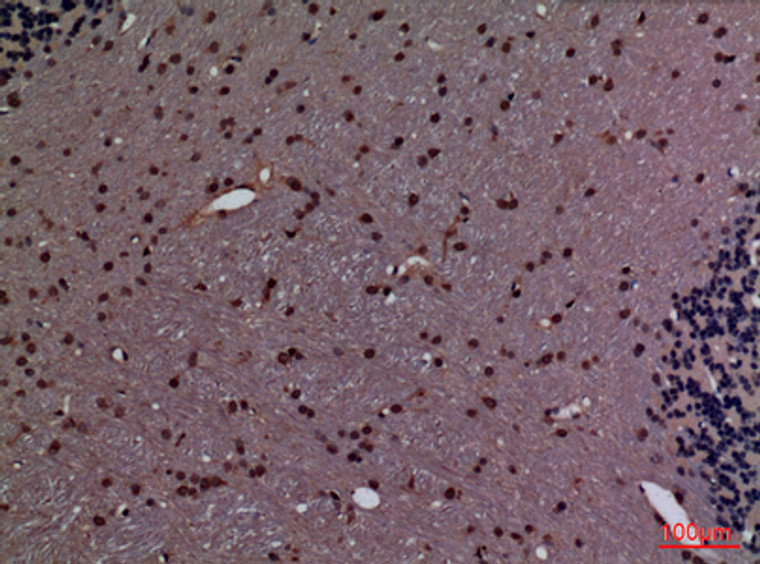| Host: |
Rabbit |
| Applications: |
WB/IHC/IF/ELISA |
| Reactivity: |
Human/Mouse/Rat |
| Note: |
STRICTLY FOR FURTHER SCIENTIFIC RESEARCH USE ONLY (RUO). MUST NOT TO BE USED IN DIAGNOSTIC OR THERAPEUTIC APPLICATIONS. |
| Short Description: |
Rabbit polyclonal antibody anti-Peptidyl-prolyl cis-trans isomerase A (51-100 aa) is suitable for use in Western Blot, Immunohistochemistry, Immunofluorescence and ELISA research applications. |
| Clonality: |
Polyclonal |
| Conjugation: |
Unconjugated |
| Isotype: |
IgG |
| Formulation: |
Liquid in PBS containing 50% Glycerol, 0.5% BSA and 0.02% Sodium Azide. |
| Purification: |
The antibody was affinity-purified from rabbit antiserum by affinity-chromatography using epitope-specific immunogen. |
| Concentration: |
1 mg/mL |
| Dilution Range: |
WB 1:500-1:2000IHC-P 1:100-300ELISA 1:20000IF 1:50-200 |
| Storage Instruction: |
Store at-20°C for up to 1 year from the date of receipt, and avoid repeat freeze-thaw cycles. |
| Gene Symbol: |
PPIA |
| Gene ID: |
5478 |
| Uniprot ID: |
PPIA_HUMAN |
| Immunogen Region: |
51-100 aa |
| Specificity: |
CyPA Polyclonal Antibody detects endogenous levels of CyPA protein. |
| Immunogen: |
The antiserum was produced against synthesized peptide derived from the Internal region of human PPIA at the amino acid range 51-100 |
| Function | Catalyzes the cis-trans isomerization of proline imidic peptide bonds in oligopeptides. Exerts a strong chemotactic effect on leukocytes partly through activation of one of its membrane receptors BSG/CD147, initiating a signaling cascade that culminates in MAPK/ERK activation. Activates endothelial cells (ECs) in a pro-inflammatory manner by stimulating activation of NF-kappa-B and ERK, JNK and p38 MAP-kinases and by inducing expression of adhesion molecules including SELE and VCAM1. Induces apoptosis in ECs by promoting the FOXO1-dependent expression of CCL2 and BCL2L11 which are involved in EC chemotaxis and apoptosis. In response to oxidative stress, initiates proapoptotic and antiapoptotic signaling in ECs via activation of NF-kappa-B and AKT1 and up-regulation of antiapoptotic protein BCL2. Negatively regulates MAP3K5/ASK1 kinase activity, autophosphorylation and oxidative stress-induced apoptosis mediated by MAP3K5/ASK1. Necessary for the assembly of TARDBP in heterogeneous nuclear ribonucleoprotein (hnRNP) complexes and regulates TARDBP binding to RNA UG repeats and TARDBP-dependent expression of HDAC6, ATG7 and VCP which are involved in clearance of protein aggregates. Plays an important role in platelet activation and aggregation. Regulates calcium mobilization and integrin ITGA2B:ITGB3 bidirectional signaling via increased ROS production as well as by facilitating the interaction between integrin and the cell cytoskeleton. Binds heparan sulfate glycosaminoglycans. Inhibits replication of influenza A virus (IAV). Inhibits ITCH/AIP4-mediated ubiquitination of matrix protein 1 (M1) of IAV by impairing the interaction of ITCH/AIP4 with M1, followed by the suppression of the nuclear export of M1, and finally reduction of the replication of IAV. (Microbial infection) May act as a mediator between human SARS coronavirus nucleoprotein and BSG/CD147 in the process of invasion of host cells by the virus. (Microbial infection) Stimulates RNA-binding ability of HCV NS5A in a peptidyl-prolyl cis-trans isomerase activity-dependent manner. |
| Protein Name | Peptidyl-Prolyl Cis-Trans Isomerase APpiase ACyclophilin ACyclosporin A-Binding ProteinRotamase A Cleaved Into - Peptidyl-Prolyl Cis-Trans Isomerase A - N-Terminally Processed |
| Database Links | Reactome: R-HSA-114608Reactome: R-HSA-162585Reactome: R-HSA-162588Reactome: R-HSA-162592Reactome: R-HSA-162594Reactome: R-HSA-164516Reactome: R-HSA-164525Reactome: R-HSA-173107Reactome: R-HSA-175474Reactome: R-HSA-180689Reactome: R-HSA-2025928Reactome: R-HSA-210991Reactome: R-HSA-6798695Reactome: R-HSA-8950505Reactome: R-HSA-9692916 |
| Cellular Localisation | CytoplasmSecretedNucleusSecretion Occurs In Response To Oxidative Stress In Vascular Smooth Muscle Through A Vesicular Secretory Pathway That Includes Rho Gtpase SignalingActin RemodelingAnd Myosin Ii Activation |
| Alternative Antibody Names | Anti-Peptidyl-Prolyl Cis-Trans Isomerase A antibodyAnti-Ppiase A antibodyAnti-Cyclophilin A antibodyAnti-Cyclosporin A-Binding Protein antibodyAnti-Rotamase A Cleaved Into - Peptidyl-Prolyl Cis-Trans Isomerase A - N-Terminally Processed antibodyAnti-PPIA antibodyAnti-CYPA antibody |
Information sourced from Uniprot.org
12 months for antibodies. 6 months for ELISA Kits. Please see website T&Cs for further guidance













